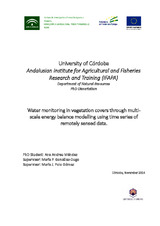Mostrar el registro sencillo del ítem
Water monitoring in vegetation covers through multi-scale energy balance moddelling using time series of remotely sensed data
| dc.contributor.advisor | González Dugo, María P. | |
| dc.contributor.advisor | Polo Gómez, María José | |
| dc.contributor.author | Andreu, Ana | |
| dc.date.accessioned | 2014-12-17T12:55:06Z | |
| dc.date.available | 2014-12-17T12:55:06Z | |
| dc.date.issued | 2014 | |
| dc.identifier.uri | http://hdl.handle.net/10396/12478 | |
| dc.description.abstract | This work has addressed the modelling of the energy balance, integrating thermal infrared data into the Two Source Energy Balance model (TSEB, Norman et al., 1995; Kustas and Norman, 1999), over two extended and valuable Mediterranean ecosystems, as the dehesa and the vineyard. Throughout the Mediterranean region, particularly in Southern Spain, the main river basins suffer an imbalance between the supply and demand for water, largely due to the variable climatic conditions and human activities. Dealing with the water scarcity situation must rely on the ability to improve management with timely and accurate information about the water status of the ecosystems, that would improved predictions of resource availability and reduced the uncertainty in decision-making processes. The integration of remote sensing data in energy balance modelling can provide this information at different spatio-temporal scales. In water-controlled ecosystems there are many interrelationships between climate, soil and vegetation, with evapotranspiration (ET) as a key variable connecting energy and water budgets. ET has been exhaustively studied in cropped systems and different models for estimating ET at medium-large spatial scales have been developed, based on both soil water balance and surface energy balance. Energy balance (EB) models based on thermal remote sensing data enable updated diagnoses of the actual surface water condition. In general, these models do not require precipitation or soil properties inputs and are mostly conditioned by surface radiometric temperature (TRAD) observations. The methodology that best accounts for the effects of a non-homogeneous partial canopy cover is the twosource approach (Shuttelworth and Wallace, 1985; Norman et al., 1995; Kustas and Norman, 1999), in particular the TSEB, in which surface fluxes are divided into soil and canopy components. Previous studies (Timmermans et al., 2007; González-Dugo et al., 2009) demonstrated the advantages of such... | es_ES |
| dc.format.mimetype | application/pdf | es_ES |
| dc.language.iso | eng | es_ES |
| dc.publisher | Universidad de Córdoba, Servicio de Publicaciones | es_ES |
| dc.rights | https://creativecommons.org/licenses/by-nc-nd/4.0/ | es_ES |
| dc.subject | Plant physiology | es_ES |
| dc.subject | Earth Observation (EO) | es_ES |
| dc.subject | Mediterranean ecosystems | es_ES |
| dc.subject | Two source energy balance model (TSEB) | es_ES |
| dc.subject | Water-controlled ecosystems | es_ES |
| dc.title | Water monitoring in vegetation covers through multi-scale energy balance moddelling using time series of remotely sensed data | es_ES |
| dc.type | info:eu-repo/semantics/doctoralThesis | es_ES |
| dc.rights.accessRights | info:eu-repo/semantics/openAccess | es_ES |

